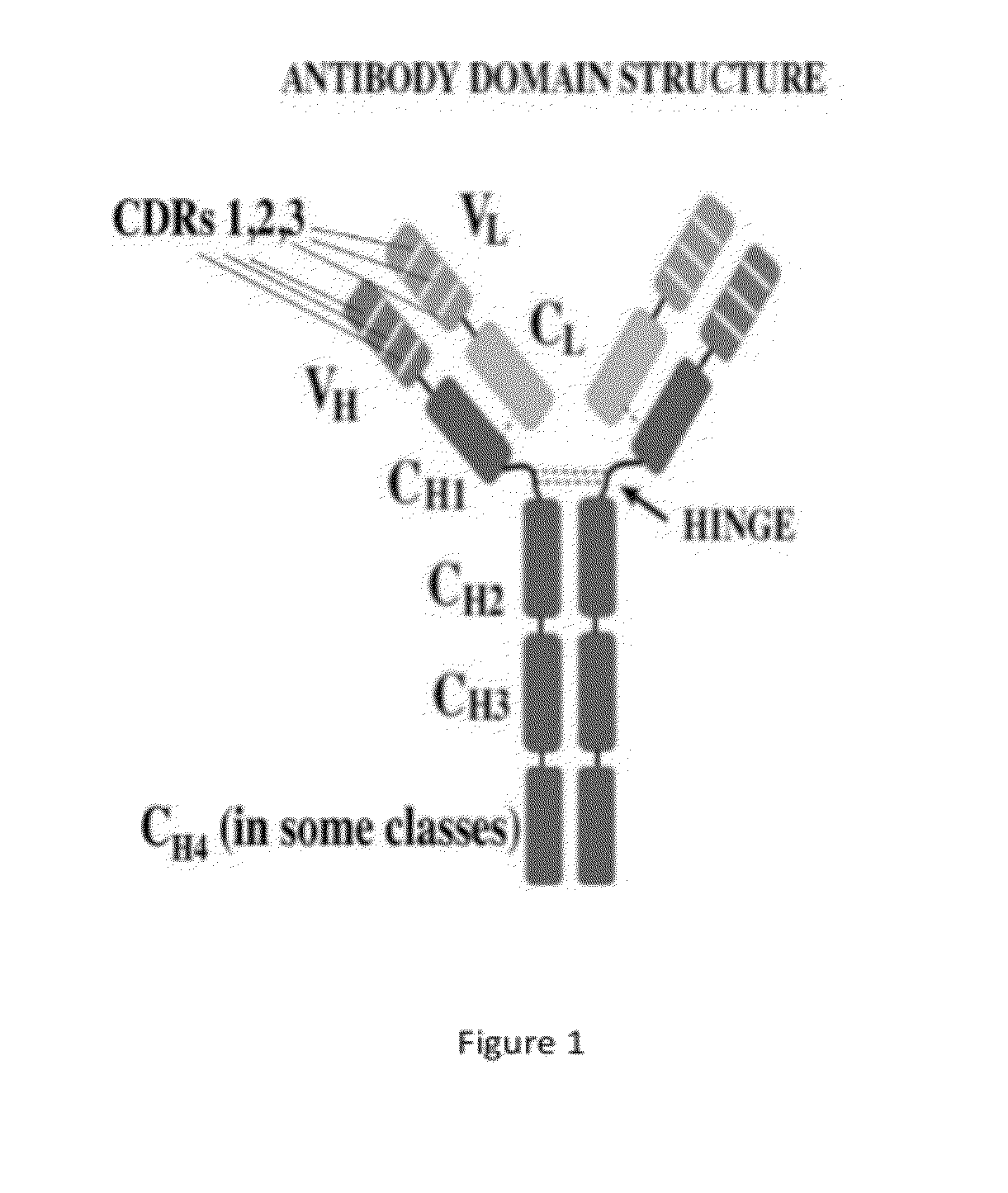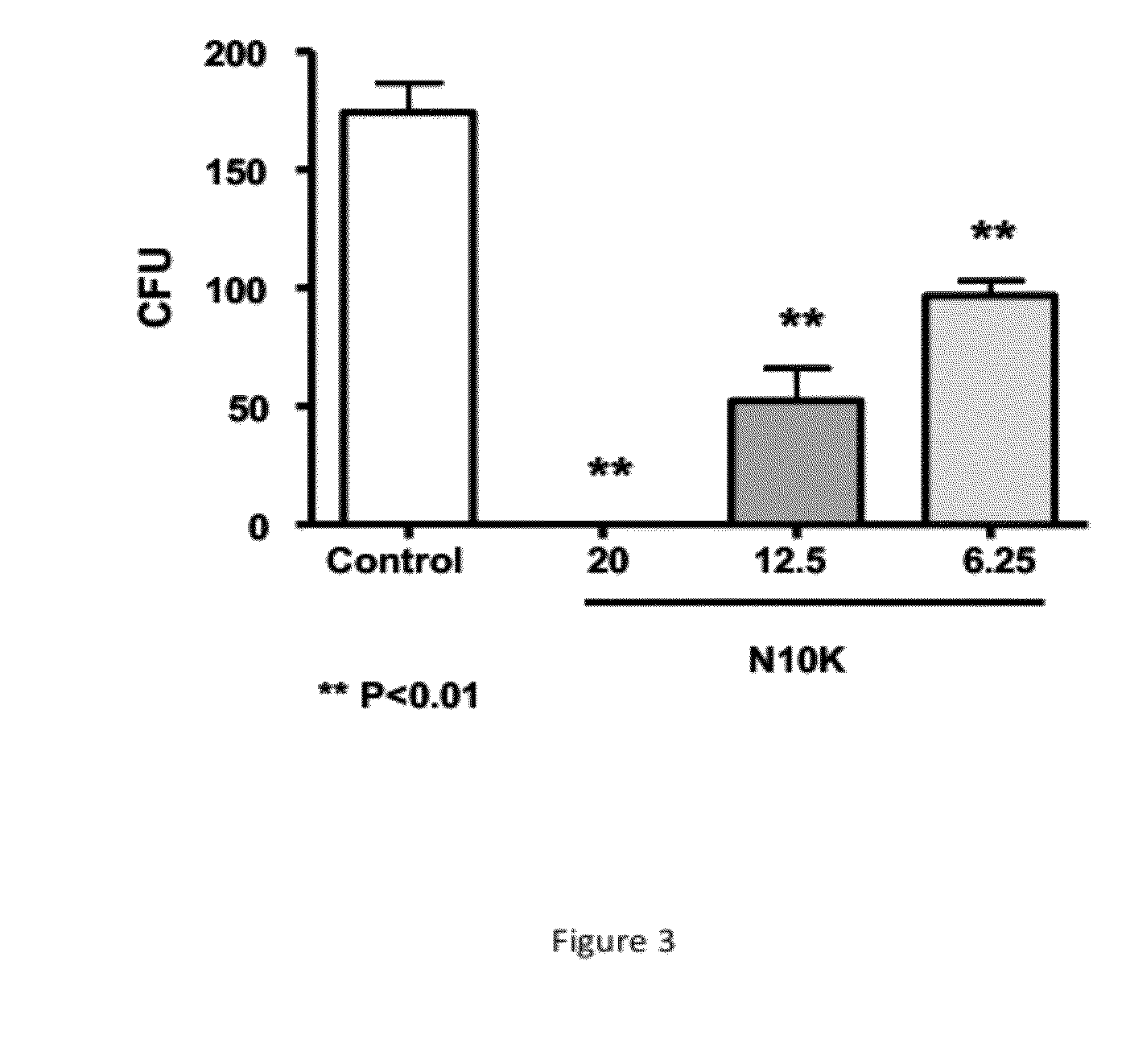Antimicrobial, antiviral, anticancer and immunomodulatory peptides and uses therefore
a technology of immunomodulatory peptides and antiviral drugs, applied in the field of immunology, can solve the problems of high morbidity and mortality, difficult treatment of invasive bacteria, and long association of ifis, and achieve the effect of improving the activity of said peptides and preserving considerable activity
- Summary
- Abstract
- Description
- Claims
- Application Information
AI Technical Summary
Benefits of technology
Problems solved by technology
Method used
Image
Examples
example 1
I. Example 1
Data for N10K Peptide
[0093]In vitro activity of N10K against C. albicans SC5314 strain. The candidacidal activity of N10K peptide against C. albicans was assessed by a conventional colony forming unit (CFU) assay as previously described (Polonelli et al., 2003; Manfredi et al., 2005). Briefly, cells of C. albicans SC5314 were incubated at 37° C. for 6 hours (hr) in the presence of N10K at the concentration indicated of 20, 12.5 or 6.25 microgram / ml, or in distilled water as control (C). After incubation, cell suspensions were plated on Sabouraud dextrose agar and incubated at 30° C. for 48 hours when CFU were counted (** PC. albicans SC5314 strain. Based on several independent replications, an EC50 of 10.04×10−6 mol / liter (95% confidence intervals 9.209-10.956×10−6) was determined.
[0094]In vivo activity of N10K against systemic candidiasis caused in immunocompetent mice by the highly virulent C. albicans CA-6 strain. The anticandidal therapeutic activity of N10K was eval...
example ii
2. Example II
Data for T11F Peptide
[0109]In vitro activity of T11F against C. albicans SC5314 strain. The candidacidal activity of T11F peptide against C. albicans was assessed by a conventional CFU assay. Cells of C. albicans SC5314 were incubated at 37° C. for 6 hours in the presence of T11F at the concentrations of 5, 3 or 2 micrograms / ml, or in distilled water as control (C). After incubation, cell suspensions were plated on Sabouraud dextrose agar and incubated at 30° C. for 48 hours when CFU were counted (** PC. albicans SC5314 strain. Based on several independent replications, an EC50 of 1.599×10−6 mol / liter (95% confidence intervals 1.017-2.514×10−6) was determined.
[0110]In vivo activity of T11F against vaginal candidiasis caused in mice by the fluconazole-susceptible C. albicans SA40 strain. The anticandidal therapeutic activity of T11F was evaluated in a murine model of vaginal candidiasis. Groups of 5 mice were injected subcutaneously with 0.02 mg of estradiol benzoate in ...
experiment iii
3. Experiment III
Data for H4L Peptide
[0123]In vitro activity of H4L against C. albicans SC5314 strain. The candidacidal activity of H4L peptide against C. albicans has been evaluated by a conventional CFU assay. Cells of C. albicans SC5314 have been incubated at 37° C. for 6 hours in the presence of H4L at the concentration of 100 micrograms / ml, or in distilled water as control growth. After the incubation period, the cell suspensions have been plated on Sabouraud dextrose agar, then incubated at 30° C. and observed for CFU enumeration after 48 hours. As disclosed in FIG. 32, H4L showed candidacidal activity against C. albicans (*** P<0.001, treated versus untreated cells, t test).
[0124]In vitro activity of H4L against C. neoformans 6995 strain. The fungicidal activity of H4L peptide against C. neoformans has been evaluated by a conventional CFU assay. Cells of C. neoformans 6995 have been incubated at 37° C. for 6 hours in the presence of H4L at the concentration of 100 micrograms / ...
PUM
| Property | Measurement | Unit |
|---|---|---|
| concentration | aaaaa | aaaaa |
| concentration | aaaaa | aaaaa |
| concentration | aaaaa | aaaaa |
Abstract
Description
Claims
Application Information
 Login to View More
Login to View More - R&D
- Intellectual Property
- Life Sciences
- Materials
- Tech Scout
- Unparalleled Data Quality
- Higher Quality Content
- 60% Fewer Hallucinations
Browse by: Latest US Patents, China's latest patents, Technical Efficacy Thesaurus, Application Domain, Technology Topic, Popular Technical Reports.
© 2025 PatSnap. All rights reserved.Legal|Privacy policy|Modern Slavery Act Transparency Statement|Sitemap|About US| Contact US: help@patsnap.com



